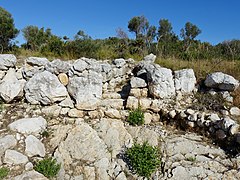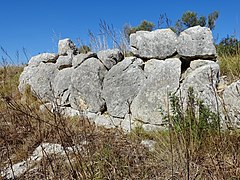Archaeological site of Mestre Ramon
| Mestre Ramon | ||
|---|---|---|
|
South side of the hill |
||
|
Location in Mallorca |
||
| Coordinates | 39 ° 38 '8.3 " N , 3 ° 23' 25.8" E | |
| place | Son Servera , Balearic Islands , Spain | |
| Emergence | after 1000 BC Chr. | |
The archaeological site of Mestre Ramon refers to an excavation site of building remains from prehistoric times on the Spanish Balearic island of Mallorca . It is located in the municipality of Son Servera in the region ( comarca ) Llevant , about 875 meters from the Badia de Son Servera ('Bay of Son Servera') on the east coast of Mallorca. The place of discovery is attributed to the end of the Bronze and Iron Ages .
location
The archaeological site is located on the top and at the foot of a 38 meter high hill in the middle of a fertile plain between the torrents Torrent de Son Jordi in the north and Torrent Nou in the south. Both streams flow in the east into the Badia de Son Servera , in the past also called Badia de Artà , the Torrent de Son Jordi between the beaches of sa Marjal and es Ribell , the Torrent Nou between the towns of Port Nou and Port Vell . From Port Vell, the MA-4032 road leads into the interior of the island, passing the Mestre Ramon archaeological site directly north in the Can Ballester area (Poligon 18, plot 261).
description
The archaeological site of Mestre Ramon occupies an oval area of about 100 meters in diameter, which is bordered by the remains of an enclosure wall. From the country road, a path leads from the northwest past the western wall remnants to the top of the hill. The hilltop is dominated by an almost round structure, the diameter of which is about 15 meters. It is also referred to as a talaiot , although its design cannot be compared with these prehistoric buildings in Mallorca.

In the step-like structure on the hill, which was built between 1000 and 550 BC. A corridor bends to the right and ends in a niche on the right. In the middle of the structure is a stone-lined pit that has no connection to the eastern corridor. Jordi Hernández, one of the leading archaeologists of the excavation campaigns that have been taking place annually since 2012 , interprets the structure as a tumulus , a stepped burial mound from the Talaiotic or pre- Talaiotic times. However, no evidence of burials was discovered. Several finds of animal bones in the interior of the tumulus led to the view that it served, among other things, as a venue for animal sacrifices. The Mestre Ramon hill may also have served as a landmark and a watch post for the surrounding area and towards the sea.
The former enclosure wall of the facility is more recent. It comes from the post-Talaiotic era from around 550 to 123 BC. The boundary of the site, which was built from large blocks of dry stone masonry, was originally closed, but today consists only of individual fragments on the east and south sides of the complex. A carved entrance can be seen to the east, which led into the interior with the tumulus 55 meters away on the hill. The excavations initiated by the Son Servera community from 2012 onwards were carried out with the participation of the University of Washington and volunteers from different countries. The finds recovered, mostly ceramics and bones, are still being evaluated.
- Views of the archaeological site
South side of the tumulus
literature
- Jordi Hernández-Gasch, Antoni Puig Palerm, Marcos Llobera, Jacob Deppen: Evolució de les comunitats prehistòriques i protohistòriques i transformació del paisatge al nord-est de l'illa de Mallorca: projecte d'estudi i resultats preliminars . In: Antonia Martínez Ortega, Glenda Graziani Echávarri (Eds.): VI Journades d'Arqueologia de les Illes Balears . Consell Insular de Formentera, Formentera 2015, ISBN 978-84-941471-6-6 , p. 23–34 (Catalan, digitized [accessed July 3, 2017]).
- Maria Gelabert Oliver, Jordi Hernández-Gasch, Antoni Puig Palerm: Updating knowledge: architecture, use and chronology of the Late Bronze Age stepped monuments in Mallorca (= Trabajos de Prehistoria . Band 75 , no. 1 ). Consejo Superior de Investigaciones Científicas , 2018, ISSN 0082-5638 , p. 128–145 (English, online [PDF; 468 kB ]).
Individual evidence
- ↑ Senderisme a Mallorca. Consell de Mallorca, accessed July 1, 2017 (interactive map).
- ↑ Jaciments Arqueològics. Polígon 18 . In: Catàleg de Patrimoni Històric, Artístic, Arquitectònic i Paisatgístic de Son Servera . Ajuntament de Son Servera, 2009, Talaiot de Mestre Ramon: Element número 2024, p. 81–83 (Catalan, digitized [PDF; accessed July 3, 2017]). Digitized version ( memento of the original from July 29, 2016 in the Internet Archive ) Info: The archive link was inserted automatically and has not yet been checked. Please check the original and archive link according to the instructions and then remove this notice.
- ^ Talaiot del Mestre Ramón, Son Servera. (PDF) sci-cat, May 26, 2015, accessed June 25, 2017 (Catalan).
- ↑ Primera campanya de neteja arqueològica al Jaciment arqueològic del Turó de l'Olivar de Son Servera. (No longer available online.) Municipality of Son Servera , April 8, 2015, formerly in the original ; Retrieved June 25, 2017 (Catalan). ( Page no longer available , search in web archives ) Info: The link was automatically marked as defective. Please check the link according to the instructions and then remove this notice.
- ↑ Son Servera organiza una jornada de puertas abiertas en el yacimiento Mestre Ramon. El Mundo , October 24, 2015, accessed June 25, 2017 (Spanish).
- ↑ Son Servera organitza una jornada de portes Obertes al jaciment Prehistoric Mestre Ramon. ARA Balears, October 4, 2015, accessed June 25, 2017 (Catalan).
- ↑ Eva Carolin Ulmer: In search of the past. Mallorca Magazin , September 28, 2014, accessed June 25, 2017 .
- ^ Landscape, Encounters, and Identity Project: 2014 Campaign - Excavation. University of Washington , accessed June 25, 2017 .
- ↑ Archaeologists publish first results about Talayot settlement on Mallorca. Inselradio , August 2013, accessed on June 25, 2017 .
- ↑ El jaciment Arqueològic de Mestre Ramon it promociona a la Universitat de Washington. CalaMillor7, February 25, 2014, accessed June 25, 2017 (Catalan).
- ^ Estudiantes de la Universidad de Washington analizan la prehistoria de Son Servera. Diario de Mallorca, September 12, 2014, accessed June 25, 2017 .
- ^ IV Campaña de intervención en el Yacimiento Arqueológico de Mestre Ramon. (No longer available online.) Municipality of Son Servera, April 14, 2014, formerly in the original ; Retrieved June 25, 2017 (Spanish). ( Page no longer available , search in web archives ) Info: The link was automatically marked as defective. Please check the link according to the instructions and then remove this notice.
- ↑ Més de 80 Kg de fragments ceràmics i ossos trobats a la darrera campanya de recerca arqueològica a Son Servera. CalaMillor7, August 25, 2015, accessed June 25, 2017 (Catalan).
Web links
- Arqueologia a Son Servera. Projecte de recerca. jacimentdemestreramon, Retrieved June 25, 2017 (Catalan).
- Landscape, Encounters, and Identity Project. University of Washington , accessed June 25, 2017 .
- Mestre Ramon. ArqueoMallorca, 2017, accessed June 25, 2017 (Catalan).
- Archaeological sites of the municipality of Son Servera. 2018, accessed May 28, 2018 (Catalan).






